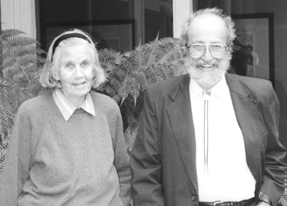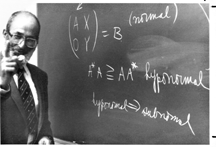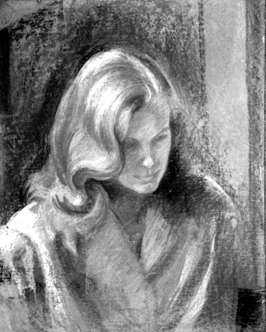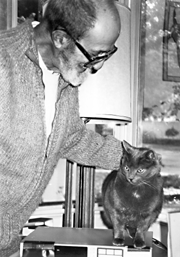- About MAA
- Membership
- MAA Publications
- Periodicals
- Blogs
- MAA Book Series
- MAA Press (an imprint of the AMS)
- MAA Notes
- MAA Reviews
- Mathematical Communication
- Information for Libraries
- Author Resources
- Advertise with MAA
- Meetings
- Competitions
- Programs
- Communities
- MAA Sections
- SIGMAA
- MAA Connect
- Students
- MAA Awards
- Awards Booklets
- Writing Awards
- Teaching Awards
- Service Awards
- Research Awards
- Lecture Awards
- Putnam Competition Individual and Team Winners
- D. E. Shaw Group AMC 8 Awards & Certificates
- Maryam Mirzakhani AMC 10 A Awards & Certificates
- Two Sigma AMC 10 B Awards & Certificates
- Jane Street AMC 12 A Awards & Certificates
- Akamai AMC 12 B Awards & Certificates
- High School Teachers
- News
You are here
Demands for Teacher Quality Spur New Initiatives
Major Donation Announced for New MAA Conference Center
By Gerald Alexanderson
The MAA recently received a gift of $3 million from Paul and Virginia Halmos to establish a Mathematical Sciences Conference Center in Washington, DC. The Association plans to restore to its former charm the exterior of its historic carriage house, one of the three buildings in the MAA complex in the Dupont Circle district, and to renovate completely the interior to accommodate conferences of up to 60 people, with ample additional space for mathematicians to meet in smaller groups or to work individually. Up to now mathematical meetings at the MAA are confined to two small conference rooms in the Vaughn Building or, if too large, they are held in facilities in Washington hotels.

Ginger and Paul Halmos
The gift will fund the renovation and construction of the space, along with furnishing and equipping the interior to provide a completely modern meeting facility. Beyond capital expenditures, the gift will provide funds that will support the programs in the Center, which the donors envision as an ongoing series of mathematically intensive workshops, symposia and seminars. Programs will reflect the range of ideas and topics for which the MAA has been long known through its many fine publications as well as programs at sectional and national meetings.

Paul Halmos has a long association with the MAA and a lifetime commitment to mathematical exposition. He was editor of the American Mathematical Monthly from 1982 to 1986, and in 2000 he was awarded the MAA’s Gung-Hu Award for Distinguished Service to Mathematics. The Association was founded in 1915 to provide a home for the Monthly and, through its many other publications, starting with the Carus Monographs in 1925, it has been an active proponent of good mathematical exposition ever since. It is not surprising then that Professor Halmos and his wife, Virginia, should choose to enhance even further the ability of the MAA to carry on this tradition of producing fine exposition by creating this meeting facility. In his “Automathography,” I Want To Be a Mathematician(Springer, 1985), page 390, Halmos explained the difference between a survey [of research results] and an expository paper—something for the reader who is not an expert but is curious about the subject, pointing out that the latter kind of paper is hard to write. But Paul Halmos has repeatedly written memorable and elegant expository papers, with a style that is easily recognizable as his own. In the same work, page 403, he wrote: “I was, in I think decreasing order of quality, a writer, an editor, a teacher, and a research mathematician.”
He has left his mark on written mathematics in two commonly observed ways: he introduced “iff” as an abbreviation for “if and only if” and denoted the end of a proof with what is sometimes known as a tombstone and now often called a “halmos.”

Virginia Halmos at Brown circa 1947.
Virginia Halmos, an alumna of Vassar College, pursued graduate work in philosophy at Brown. She and Paul married in 1945 and since then she has been a supporter and partner to Paul throughout his wide-ranging career. Larry Wallen, a longtime friend and mathematician at the University of Hawaii, in his contribution to the volume Paul Halmos: Celebrating 50 Years of Mathematics (Springer, 1991), wrote of her: “Late that summer [1955] I met Virginia (Ginger) Halmos, a striking woman I recall thinking. Any picture of Paul that omits Ginger is grossly incomplete. In the first place, she’s crucial to keeping the entropy of the Halmos household improbably small and in keeping Paul and the cats hale and hearty. This, of course, doesn’t define Ginger. She’s a woman of remarkable intelligence with a fine wit that not everybody is privy to. She’s the ecological Halmos who fishes floundering lizards from the pool and worries about wetlands.” As interested as she is in being a good citizen of her community with her volunteer work, in quietly supporting animal welfare programs, and in following her strong interest in literature (even in Latin), she has nevertheless lived most of her life around mathematicians and has an extensive knowledge of mathematical culture. With happy memories of visits to Oberwolfach, Ginger has been an enthusiastic force behind the establishment of the MAA Conference Center since conversations on possibilities began. Paul Halmos’ own fond reminiscences of Oberwolfach appear in his’ “Automathography,” pp. 384-87.

Professor Wallen mentioned cats. To know Paul and Ginger Halmos well one has to know that they are both avid animal lovers. They have in recent years had cats but they love dogs equally well. Don Albers, in one of his interviews with Paul, noted that during the interview Paul had, sitting on his lap, Pizzicato (a suitable name for a cat owned by someone interested in words and music). When asked whether anything about cats especially appealed to him, Paul replied: “Do animals have souls? People debate the subject, and I stand firmly on the affirmative. But what is it that appeals? Well, they look nice, they’re interesting, they’re loving, they’re lovable, and somehow one is in touch with another soul. They enlarge one’s life a little bit.”
For his expository writing Paul Halmos has received from the MAA the Chauvenet Prize (1948), two Lester R. Ford Awards (1971, 1972), and the George Pólya Award (1983), and, from the American Mathematical Society, the Leroy P. Steele Prize for Mathematical Exposition (1983).

Highly respected as a teacher, and an advocate for a modified Moore method, he won both the sectional award and the MAA’s national Deborah and Franklin Tepper Haimo Award for Distinguished College or University Teaching of Mathematics in 1993 and 1994, respectively. In support of these teaching awards, one former student wrote, “He stresses above all the need for clear oral and written communication of ideas as a prerequisite to good mathematics. Several times, [as I was] struggling over an explanation, he would cut me off and demand that I say exactly what I meant… [He asks] questions to draw out the answers. This technique thoroughly involves students in class, giving them a personal stake in the process of discovery. Of all the things I saw in Dr. Halmos’ class I never saw someone yawn and look at the clock.” Another wrote: “That quarter the only class I looked forward to was Paul Halmos.’ Our classroom discussions were always animated, interesting, and even sometimes humorous… He often asked us to be ‘mindreaders,’ and tell him what he was thinking. If we didn’t know the answer to a question that he expected we should have known, he would swing his arm in a motion that we came to understand as our decapitation. Some of the funnier moments in class came when we realized that we could sometimes avoid this motion by giving a silly answer, causing Dr. Halmos to laugh.” One former student wrote him to tell him how much he had enjoyed his classes, and closed with “you are an inspiration and you should demand that Santa Clara University throw parades in your honor every month or so!”
Paul Halmos received his B.S., M.S., and Ph.D. at the University of Illinois, writing his dissertation under the direction of J. L. Doob. After a period at the Institute for Advanced Study (IAS), Princeton, where he was assistant to John von Neumann (1940-42), he returned briefly to Illinois. Since then he has held faculty positions at the following universities: Illinois, Syracuse, Chicago, Michigan (Ann Arbor), Hawaii, California (Santa Barbara), Indiana, and Santa Clara, where he became professor emeritus in 1995. He and his wife now live in Los Gatos, California.
Along the way Professor Halmos has held visiting appointments at Harvard, Tulane, Montevideo, Miami (Florida), California (Berkeley), Washington (Seattle), Edinburgh, Chiao Tung (Taiwan), and Western Australia, as well as several visits to the IAS. He has written over 100 research papers and many reviews in his principal research fields of operator theory, algebraic logic, and ergodic theory, with additional work in topological groups, probability, statistics, and Boolean algebras. Two volumes of his work appear as Selecta, published by Springer-Verlag.
Honors have included a Guggenheim Fellowship, membership in the Royal Society of Edinburgh and the Hungarian Academy of Sciences, and honorary doctorates from St. Andrews, DePauw, Waterloo, and Kalamazoo.
Widely known as an editor, in addition to his years of editing the Monthly, Paul Halmos has held similar positions with Mathematical Reviews, the Proceedings of the American Mathematical Society, the Journal für die Reine und Angewandte Mathematik (Crelle’s Journal),Mathematical Spectrum, the Indiana Journal of Mathematics, as well as the Ergebniße der Mathematik, the Undergraduate Texts series, the Graduate Texts series and the Problem Books series for Springer-Verlag.
More than one generation of mathematicians has benefited from his famous and groundbreaking text, Finite-Dimensional Vector Spaces (1942, 1958, 1974). Others are devoted to his Measure Theory (1950, 1974), Naive Set Theory (1960, 1974), and the Hilbert Space Problem Book (1967, 1974, 1982). Four of his sixteen books are currently available from the MAA: I Want To Be a Mathematician/An Automathography (1985, 1988), Problems for Mathematicians Young and Old(1991), the Linear Algebra Problem Book (1995), and Logic as Algebra (with Steven Givant) (1998). Another popular book of his is I Have a Photographic Memory (1987). He has also written on how to write mathematics and how to give a mathematical talk in “How to write mathematics,” L’Enseignement Mathématique 16 (1970), 123-52; “How to talk mathematics,” Notices Amer. Math. Soc. 21 (1974), 155-58; and “What to publish,” Amer. Math. Monthly 82 (1975), 14-47, in addition to parts of his “Automathography.”
Paul Halmos has always made a case for the equal importance of proof and conceptual understanding in mathematics, so he emphasizes ideas in addition to proofs. This he shares with other great teachers. His concern for expository writing was summed up nicely in his response to receiving the Steele Prize:
“Not long ago I ran across a reference to a publication titled A method of taking votes on more than two issues. Do you know, or could you guess, who the author is? What about an article titled On automorphisms of compact groups? Who wrote that one? The answer to the first question is C. L. Dodgson, better known as Lewis Carroll, and the answer to the second question is Paul Halmos.
“Lewis Carroll and I have in common that we both called ourselves mathematicians, that we both strove to do research, and that we both took very seriously our attempts to enlarge the known body of mathematical truths. To earn his living Lewis Carroll was a teacher, and, just for fun, because he loved to tell stories, he wrote Alice’s Adventures in Wonderland. To earn my living, I’ve been a teacher for almost fifty years, and, just for fun, because I love to organize and clarify, I wrote’ Finite-Dimensional Vector Spaces. And what’s the outcome? I doubt if as many as a dozen readers of these words have ever looked at either A method of taking votes… or On automorphisms… but Lewis Carroll is immortal for the Alice stories, and I got the Steele Prize for exposition…"
“I enjoy studying, learning, coming to understand, and then explaining, but it doesn’t follow that communicating what I know is always easy; it can be devilishly hard. To explain something you must know not only what to put in, but also what to leave out; you must know when to tell the whole truth and when to get the right idea across by telling a little white fib. The difficulty in exposition is not the style, the choice of words—it is the structure, the organization. The words are important, yes, but the arrangement of the material, the indication of the connections of its parts with each other and with other parts of mathematics, the proper emphasis that shows what’s easy and what deserves to be treated with caution—these things are much more important.”
When I was thinking about how to write this announcement for FOCUS, I asked Virginia Halmos how she would like to be described. She told me she is a “housewife.” While it is true that she has made her career inside the home, she has distinguished herself by reading widely and participating in many community activities. She is truly a partner of Paul’s in her appreciation of the written word. I never fail to be amazed at the range of things she knows about and her erudition. Our most recent e-mail exchange on literary matters (the week before I started writing this) concerned a piece of verse by Walter Savage Landor. That led to a question of a proper translation of the Latin inscription on Hadrian’s tomb. And so it goes. How many people today can rattle off the nine ranks of angels in medieval angelology? We have all heard about seraphim, cherubim, archangels, and angels, but how many of us can come up with the rest of them, the thrones, dominions, virtues, powers, and principalities? Virginia Halmos can and does, in order of rank.
Paul and Virginia Halmos have devoted their lives to the exposition and understanding of difficult ideas. Paul’s many publications will live on for years to come. Now this remarkable couple are making it possible for the MAA to continue in the dissemination of mathematical ideas beyond the existing journals, books, regional and national meetings, minicourses, and special sessions, with an ongoing series of programs at the MAA Conference Center in Washington. Use of the facility will not be limited to the MAA. Other mathematical organizations will be invited to hold programs at the Center. Two such organizations have offices in the MAA buildings-the American Mathematical Society Washington Office and the headquarters of the Conference Board of the Mathematical Sciences. The MAA is setting up an Advisory Board to advise the officers and MAA Board of Governors on programs for the new facilities. The Board welcomes suggestions from MAA members for activities to be held at the new Center. This is a great opportunity for the MAA to expand significantly the programs it offers to members and the larger community it serves.
Gerald Alexanderson is Michael and Elizabeth Valeriote Professor of Mathematics at Santa Clara University.
id:
4213
News Date:
Thursday, January 16, 2003




